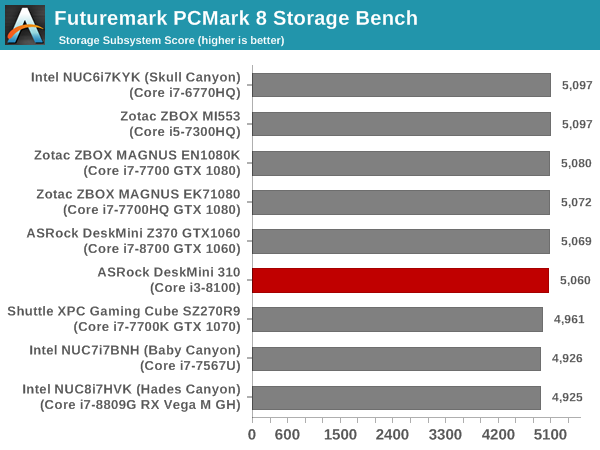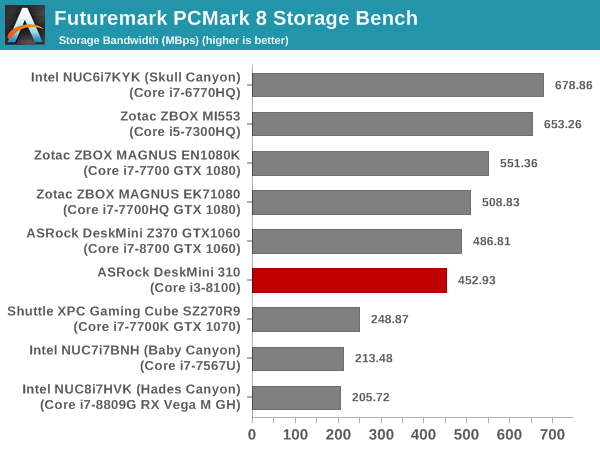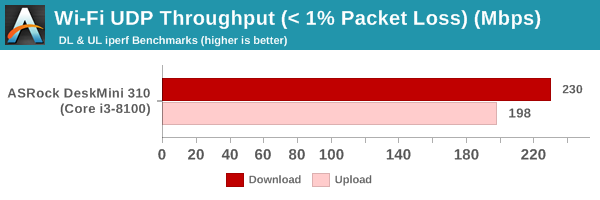The ASRock DeskMini 310 Mini-PC Review: A Cost-Effective Mini-STX Platform
by Ganesh T S on March 15, 2019 9:30 AM ESTNetworking and Storage Performance
Networking and storage are two major aspects which influence our experience with any computing system. This section presents results from our evaluation of these aspects in the ASRock DeskMini 310. On the storage side, one option would be repetition of our strenuous SSD review tests on the drive(s) in the PC. Fortunately, to avoid that overkill, PCMark 8 has a storage bench where certain common workloads such as loading games and document processing are replayed on the target drive. Results are presented in two forms, one being a benchmark number and the other, a bandwidth figure. We ran the PCMark 8 storage bench on selected PCs and the results are presented below.


The NVMe SSD used in the DeskMini 310 allows it to be clear of the SATA-using PCs in the above graphs. However, the 240 GB capacity point and general performance prevent the drive from moving up the graph.
On the networking side, we restricted ourselves to the evaluation of the WLAN component. Our standard test router is the Netgear R7000 Nighthawk configured with both 2.4 GHz and 5 GHz networks. The router is placed approximately 20 ft. away, separated by a drywall (as in a typical US building). A wired client is connected to the R7000 and serves as one endpoint for iperf evaluation. The PC under test is made to connect to either the 5 GHz (preferred) or 2.4 GHz SSID and iperf tests are conducted for both TCP and UDP transfers. It is ensured that the PC under test is the only wireless client for the Netgear R7000. We evaluate total throughput for up to 32 simultaneous TCP connections using iperf and present the highest number in the graph below.

In the UDP case, we try to transfer data at the highest rate possible for which we get less than 1% packet loss.

These bandwidth numbers are consistent with what one can expect from a 1x1 client radio.










48 Comments
View All Comments
imaheadcase - Friday, March 15, 2019 - link
$523 (no OS). That is the problem with these type of things. It ends up being expensive that you could build own without investing in a SFF like that.At that price be better off getting a intel NUC
Alistair - Friday, March 15, 2019 - link
Basically Microsoft's monopoly and ridiculous Windows pricing (Microsoft just raised the price to $212 after tax in Canada, no freaking joke) can wreck any builder's day. Steal it or get a grey market $20 dollar copy from India. No remorse whatsoever. Who honestly thinks a price of $212 is warranted??? Government should have stepped in and limited the price to $50 a long time ago.Alistair - Friday, March 15, 2019 - link
Windows 10 Home OEM $212 after taxes:https://www.microsoft.com/en-ca/p/windows-10-home/...
Mr Perfect - Friday, March 15, 2019 - link
Oh, yeah, don't buy direct from MS. Newegg Canada has it for almost half that. https://www.newegg.ca/Operating-Systems/SubCategor...close - Friday, March 15, 2019 - link
Alistair, what's your day job? Because I'm entirely sure the government should have stepped in and limited your income to 25% of whatever you're making now a long time ago. Governments should do that you know...isthisavailable - Sunday, March 17, 2019 - link
Or just run insider preview builds in the slow ring for free?close - Monday, March 18, 2019 - link
No! It has to be stable. And free.Qasar - Sunday, March 17, 2019 - link
i agree... dont buy direct from microsoft... 2 comp stores here.. have win home 64 but for 140 cdn or less, even as low as 120 when on sale...Death666Angel - Friday, March 15, 2019 - link
I don't get it. This thing costs 150€ for a mainboard, case, PSU and WiFi. The cheapest 1151v2 ITX mainboard start at 75€, plus an ITX case with a PSU is another 50€ at least. So that is at least 125€ and no WiFi. It is also a helluvalot larger, but has better upgradeability. But you probably don't care about that, since you mention NUCs as a comparison.The cheapest current i3 (15W) NUC starts at (German prices) 260€. The DeskMini with a (much more powerful) i3-8100 (65W) costs 270€. And this thing actually can take a 6C/12T i7-8700. So it is not much more expensive, but definitely more versatile and powerful than a NUC.
Don't look at the "as configured" bit and compare it to what you would buy or bought a while ago. Ganesh uses the same things for everything for comparison sake and did not look for deals or what makes sense for the individual build. You can shave a lot of costs off by using M.2 SATA drives and other RAM for example. My config with brand new parts would be 420€ wtih 2x8GB DDR4, 500GB MX500 and a i3-8100.
sudhansu9dm - Friday, March 15, 2019 - link
Thanks for the reviewing this! I think this is a fantastic form factor held back by the use of older and nerfed chipsets.